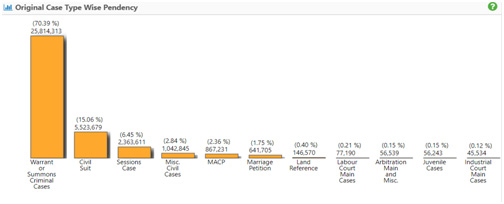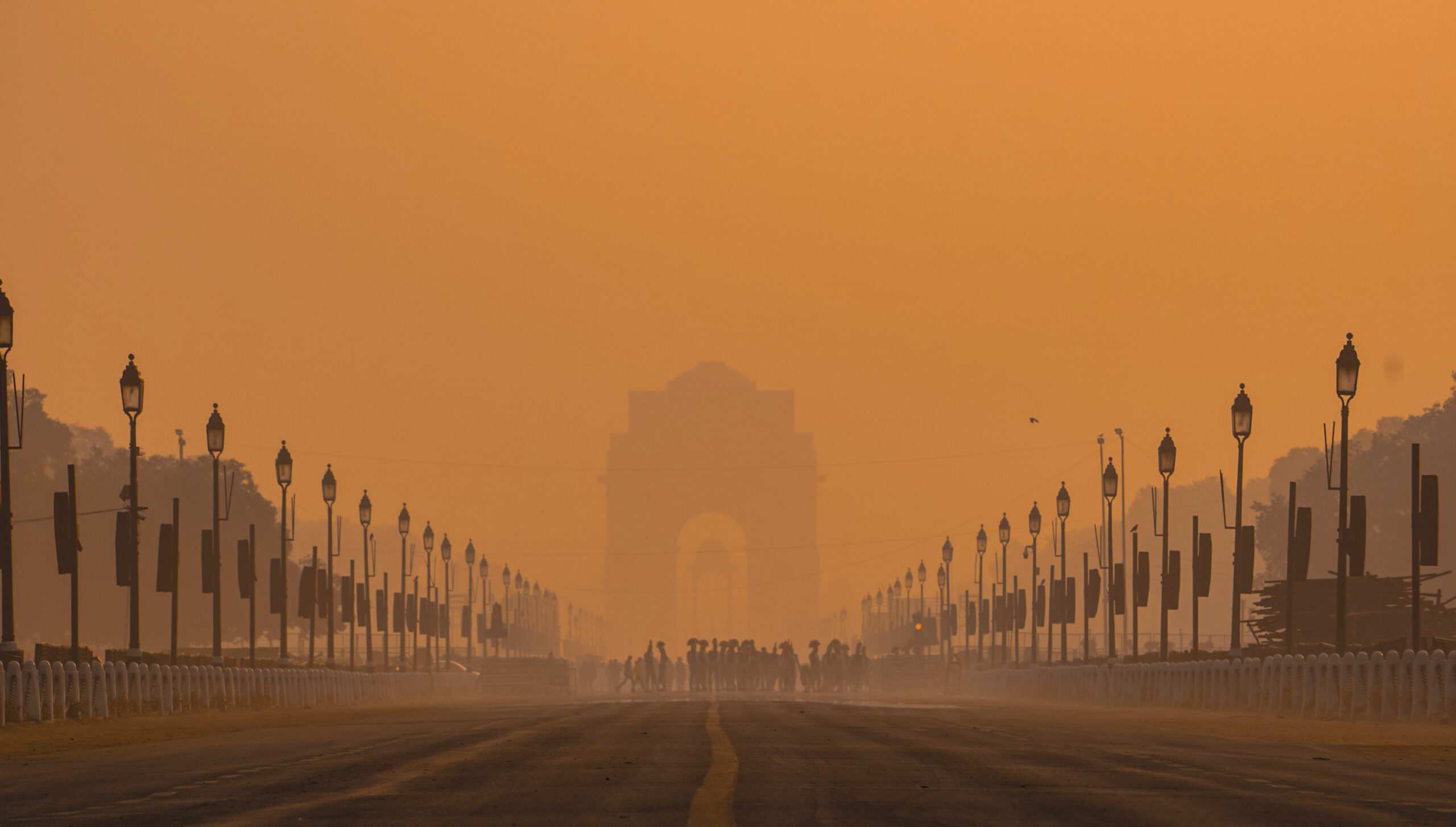“Judicial reform is the concern not only of the Judiciary, but it is the responsibility of the Executive, of the Legislature, of the Bar and of the people also. It is not a one-time remedy, but an on-going process.”
The Law Commission of India, (Report No. 222 – ‘Need for Justice-dispensation through ADR etc.’)
One of the most cherished goals of any justice delivery system is quick and affordable justice to all. However, the sheer size and population of the country and ever-increasing disputes in the society have led to a humongous rise in litigation which has over-burdened the Judiciary. With the rise economic activities, coupled with low judge-to-population ratio and unfilled vacancies of Judges at all levels, the caseload has risen to an unmanageable proportion. In such a scenario, Alternative Dispute Resolution (ADR) mechanisms like arbitration, conciliation and mediation come in handy. These ADR mechanisms are less adversarial and are capable of providing a better substitute to the conventional methods of resolving disputes.[1]
The overburdened judicial system is not in a position to cope up with the heavy demands on it mostly for reasons beyond its control. Speedy justice has become a casualty, though the disposal rate per-Judge is quite high in our country. Article 39A of the Constitution of India (enacted in 1976) enjoins that the State shall secure that the operation of the legal system promotes justice, on a basis of equal opportunity, and shall, in particular, provide free legal aid, by suitable legislation or schemes, to ensure that opportunities for securing justice are not denied to any citizen by reason of economic or other disabilities. Thus, easy access to justice to all sections of people and provision of legal aid for the poor and needy and dispensation of justice by an independent Judiciary within a reasonable time are the cherished goals of our Constitutional Republic and for that matter, of any progressive democracy.[2]
Role of Mediation in Downsizing the Pendency:
The conflict resolution processes of Arbitration, Conciliation, Negotiation and Mediation are known as Alteranate Dispute Resolution (ADR) mechanisms and have gained prominence in the 20th century. With the overburdened judicial system, the time has perhaps come to reconsider the status of Alteranate Dispute Resolution (ADR) mechanisms as ‘alternatives’. Given the huge pendency in Indian courts, and more importantly, the effectiveness of ADR mechanisms to quickly resolve certain categories of disputes, they should be treated at par with the public court system. In fact, in some categories, they should be treated as primary choice of dispute resolution.
Mediation is a process in which an impartial and neutral third person, the mediator, facilitates the resolution of a dispute without suggesting what should be the solution. It is an informal and non-adversarial process intended to help disputing parties to reach a mutually acceptable solution. The role of the mediator is to remove obstacles in communication, assist in the identification of issues and the exploration of options and facilitate mutually acceptable agreements to resolve the dispute. However, the ultimate decision rests solely with the parties. A mediator cannot force or compel a party to make a particular decision or in any other way impair or interfere with the party’s right of self-determination.[3]The concept of mediation evolved in the latter half of the 20th century, however, the roots of mediation can be traced way back to the ancient Indian legal systems for example the systems known as the “Gram Panchayats” and “Nyaya Panchayats” were popular and widely prevalent in ancient rural India.[4]
The pending cases at various Courts:
As per the reply submitted by the Law Ministry, Government of India,[5] in March, 2023, the no. of cases pending in High Courts[6] (60,50,600) & District Courts[7] (4,27,18,466) were 4,87,69,066.Whereas, the number of cases where Government is party including the estimated pending Criminal Cases were as under: –
| Sr.No. | Courts | Government Cases (including criminal cases) |
| 1. | High Courts | 16,99,622 |
| 2. | District &Taluka Courts | 3,18,47,225 |
| 3. | Total | 3,35,46,847 |
As we see, of the total 4,8769,066 nos. of cases pending in the High Court and the lower courts, there are 3,35,46,847 (almost 70%) cases involving the government as a litigator. It may also be noted that the contribution of government cases is greater in percentage at lower levels and goes down at the upper levels of High Courts and Supreme Court. To be fair, the government may not be the initiator of all these litigations but sometimes involved as respondent but the contribution of these case in clogging the judicial system has been gigantic.
Pendency at Supreme Court:
As on 02.08.2022, as per information provided by Supreme Court of India, the total number of pending cases in Supreme Court of India are 71,411 out of which 56,365 are civil matters and 15,076 are criminal matters.[8]The following are the number of cases where the Central Government is a party (As per the data available on Legal Information Management and Briefing System (LIMBS) Portal, which is entered by 57user Ministries /Departments) of Government of India):
Even at the Supreme Court level the contribution of the government cases (only the Central government) is to the tune of 25% which could be substantially much more if the cases involving the state governments are to be added.
The pendency has only been rising over the years. The pendency figures compared with corresponding data in 2016, shows that there has been a rise of 50% in both levels i. e. High Court as well as lower courts[9]:
| Sr. No. | Courts | Pendency in 2016 | Pendency as in July 2022 |
| 1. | High Courts | 40,28,591 | 59,55,907 |
| 2. | District &Taluka Courts | 2.82 Crores | 4.24 Crores |
There appears to be no remedy in sight despite several efforts directed at reducing the increasing litigation.The governments, at Centre and in states are regularly criticised for not doing enough to bring down their litigation. Prime Minister Narendra Modi, too, has given a call to “lessen the load on the judiciary,” which ends up spending its maximum time in hearing cases where the government is a party. Though the National Litigation Policy-2010 had attempted an action plan to reduce government litigation and was even subsequently revised to make it more effective, it continues to be followed more in breach.
Non-performance of various wings of the executive and legislature has been cited as the reason for the government being the biggest litigants, accounting for nearly 70 per cent of the over 4 crore cases pending in various courts. Such large number of pending cases is a cause of major concern with even the highest echelons of the judiciary, including former chief justices of India, highlighting it in public platforms.At the inaugural session of the joint conference of chief ministers and chief justices of high courts last year, the then Chief Justice of India (CJI) N.V. Ramana blamed the “non-performing executives” as one of the causes for rising caseload, apart from ambiguities in laws and low judge-population ratio of 20 judges per 10 lakh people.Later, addressing the ISB Leadership Summit in September 2022, he said that half of the judiciary’s problems will be resolved if it decides to put a halt to state-sponsored litigations.
Another former CJI T.S. Thakur also voiced his concern over the issue when in office. Prior to his taking over the CJI’s post, he criticised both, the central and the state governments for being the “biggest litigant”, saying that a large number of cases pending against it was “not a good sign of good governance”. He urged the government to be “responsive to prevent cases coming to the courts”.The Karnataka High Court has castigated the state government for causing a ‘docket explosion’[10] in the judiciary through unnecessary litigation and has warned that exemplary cost would be imposed on it if it continued to do so.Dismissing the petition as “meritless”, the court said that merely being the biggest litigant does not entitle the government to file “all and sundry cases which eat into judicial time”.
The role of Mediation in reducing the pendency at Courts:
Mediation is deeply embedded in Indian ethos and was prevalent in India much before the arrival of British. Justice NV Ramana, Chief Justice of India, (Retd. CJI) while delivering the keynote address at the India-Singapore mediation summit: Mediation for Everyone: Realizing Mediation’s Potential in India, said that long before the arrival of the British adversarial system in India, various forms of mediation were practiced as a method of dispute resolution. Referring to the attempt made by Lord Krishna in the ancient epic Mahabharata, to mediate a settlement between the Kauravas and Pandavas, he said, “Dispute resolution through mediation was part of the tradition. India and numerous Asian countries have a long tradition of collaborative and amicable settlement of disputes. Mediation as a concept, is deeply embedded into the Indian ethos.” … However, the establishment of the British courts system, in 1775, marked the erosion of community-based indigenous dispute resolution mechanisms in India.” Highlighting the role of ADR in reducing the court pendency, he said that,”Alternate Dispute Resolution (ADR) mechanisms, particularly mediation and conciliation, can reduce pendency, save resources and time, and allow litigants a degree of control over the process and outcome of their dispute resolution process.”[11].
The Law Commission of India has in its various Reports had expressed concern over clogging of judiciary and stressed upon the need to look outside the existing conventional system for dispute resolution.The recommendations by the Law Commission and the report of the Arrears Committee headed by Justice V. S. Malimath paved the way for the enactment of Arbitration and Conciliation Act, 1996. However, the Mediation as a form of dispute resolution had not become very prominent at that time. As such, of the three most recognized methods of ‘Alternate Dispute Resolution’ methods ‘arbitration’, ‘conciliation’, and ‘mediation’, the first two have statutory backing in the Arbitration and Conciliation Act, 1996 whereas there is no legislation governing mediation in the country. Nonetheless, there are certain statutes which contain provisions with respect to mediation of conflicts arising therein.
Some of these statutes are:
- Industrial Disputes Act, 1947 – Section 4 of the Act assigns conciliators the responsibility to mediate and settle industrial disputes and prescribes the procedure to be followed.
- Companies Act, 2013 – Section 4 provides for the referral of disputes to mediation by the National Company Law Tribunal and the Appellate Tribunal.
- Micro, Small and Medium Enterprises Development Act, 2006 – The Act mandates mediation and conciliation when disputes arise.
- Hindu Marriage Act, 1955 and Special Marriage Act, 1954 –disputes relating to marriage and divorce to be referred to and settled by mediation.
- Real Estate (Regulation and Development) Act, 2016 – Section 32(g) provides for the amicable settlement of disputes through an established dispute resolution forum.
- Commercial Courts Act, 2015 – The new amendment made to the Act in 2018 provide for mandatory mediation between parties before filing of a suit.
- Consumer Protection Act, 2019 – The Act dedicates an entire Chapter to the resolution of disputes through mediation first before approaching a consumer redressal agency.
Besides, the enactment of Section 89 of the CPC, 1908 marked a major step towards institutionalizing ADR through its incorporation in the civil procedure.[12] This provision empowers civil courts to refer civil disputes to, among other things, mediation, ‘where it appears to the court that there exist elements of a settlement which may be acceptable to the parties.’
While the introduction of Section 89 was a landmark step, the constitutional validity of the amendment was soon challenged in Supreme Court and it quickly became apparent that the poor and hurried drafting of the provision was resulting in more problems than solving any. The Supreme Court referred to the provision as ‘a trial judge’s nightmare’.[13]Taking notice of various lacunas in the drafting of Section 89, Hon’ble Mr. Justice R.V. Raveendran has observed “Section 89 apparently was drafted in a hurry. It is not very happily worded. It is not very practical. But the object behind Section 89 is sound…… .”[14]The Law Commission vide its 238threport which was exclusively on this issue, had recommended recasting of the whole Section 89 of Code of Civil Procedure, 1908.[15]
Nevertheless, despite several provisions for mediation being in place in various statutes,the mediation is still just an option in India, not often preferred by parties due to the lack of recognition and the absence of a uniform structure to execute the resolution agreement and make it enforceable by the legislature and the judiciary.Owing to inadequacies of these statutes with respect to adoption of Mediation as an effective tool to resolve conflicts, the legal experts and judgeshave been advocating the need of having a dedicated law on Mediation. The former Chief Justice of India (Ex. CJI) Shri SA Bobde while speaking at the third edition of the international conference on Arbitration in the Era of Globalisation, organised by the Indian Council of Arbitration and the Federation of Indian Chambers of Commerce and Industry had called for the introduction of a law to ensure that all settlements arrived at in mediation proceedings are binding, and spoke in favour of compulsory pre-litigation mediation to reduce the backlog of cases in courts and save the time of both the courts and litigants.The problem, Shri Bobde said, was that ADR mechanisms such as arbitration and mediation were seen as secondary options and unless that mindset changes, steps to reform and promote such mechanisms will remain ineffective[16].
Even Justice NV Ramana, Chief Justice of India, (Retd. CJI) while delivering the keynote address at the India-Singapore mediation summit: Mediation for Everyone: Realizing Mediation’s Potential in India, highlighted the requirement for a law to make mediation the mandatory first step in the dispute resolution process.[17]
The Mediation Bill, 2021
As such, there was an urgent need for an overarching mediation legislation that could dependably govern all types of mediation in the country.With this object in mind, a dedicated bill ‘The Mediation Bill, 2021’ has been introduced in Rajya Sabha in July, 2022 and it is touted to have the potential to fundamentally alter the dispute resolution landscape of the country.[18] The features of the Bill are:
- It gives the uniform definition and meaning of mediation, mediators, and other legal terms and explains the concept of pre-litigation mediation.
- It also promotes institutional mediation as a mechanism to resolve disputes.
- It further enlists the disputes that are not fit for mediation and are excluded under the Bill from such proceedings.
- It defines the role and functions of mediators and provides provisions for their appointment, termination, and replacement.
- It provides that all the agreements or settlements of mediation will be binding on the parties and have the same effect as if passed by the courts.
- It also gives the power to the courts and tribunals the power to refer a case to mediation and outlines the steps to be followed in such a process.
- The parties have been given a right under the Bill to withdraw from the mediation proceedings or request to change the mediator.
- It envisages the enforcement of mediated settlement agreements and their challenges.
- To fulfil the objective of digital India, it also provides provisions for online mediation.
- One of the most important features of the Bill is the establishment of the Mediation Council of India, which is a formal legal authority to deal with mediation and issues arising from its mechanisms.
- It prescribes the composition of the council, the incorporation of members, their retirement, and their termination, along with its powers and functions.
- It further explains the concept of community mediation and its procedures.
- It also deals with mediation funds, accounts, and necessary audits and provides provisions for mediation service providers.
Section 2 of the Bill explains the applicability of the Bill. It says that the Bill will be applicable to all mediations in the country where:
- All the parties to a dispute are either residing in India, or incorporated here, or carry on business in India or
- Where the mediation agreement provides any such dispute will be resolved by mediation according to the provisions of the Bill or
- Where there is international mediation.
It further provides that it will not be applicable if one of the parties or both parties are central or state government, public bodies, corporations, or local bodies, entities owned and controlled by such government except in cases where the matter involves a commercial dispute between the parties. As we see in Section 2, the government disputes are only partly covered.
Mediation of criminal cases
In criminal matters also, the settlement is recognized by the Code of Criminal Procedure vide section 320 provides for compounding of several offences mentioned therein. Hence, the concept of ADR is not alien to the criminal jurisprudence in India. Nevertheless, the administration of criminal justice in India is predominantly adversarial; largely based on ‘retributive justice’. In retributive justice, it is considered that since the wrongful act is committed against society, prosecution is the state’s prerogative as the protector of citizen’s right. In any criminal case, the wrongdoer is at the center of the trial and prosecution is handled by the state as the prosecuting party, the victim of the crime is sidelined as just a witness in the case.However, the retributive system of justice often does not deliver complete justice to the victim of crime. The scholars have argued that the traditional concept of retributive justice, while offering a justification for punishment of the accused, is unable to offer a complete theory of justice.
In contrast, there is the Restorative theory of justice which focuses on the victim and the community, in addition to seeking penalty for the offender. The moment we lean to the restorative system of justice, Mediation comes across as the most effective and useful medium of ADR for criminal cases. Many countries all over the world have started incorporating the practice of restorative justice in their legal system. The fundamental premise of restorative justice is understanding the needs of the victim and factoring in the element of restorative compensation into the criminal justice system. It broadly seeks to empower the victim and enable the offender to realize the consequences of his actions.[19] The avenues and methods for practicing this form of justice are numerous and diverse, the most popular being the Victim Offender Mediation (VOM) model. This model brings the victim and the offender together to talk about the offender’s crime, facilitated by a mediator.[20] The victim relates the injurious effect that the incident had on him/her and the offender, in turn, relates the reason for his conduct and tries to satisfy the victim’s queries. In New Zealand, Family Group Conferences are prevalent and induce the participation of the victim and their family, the wrongdoer and other members of the community affected by the crime and have played a role in reducing recidivism in the country.[21] Similar purpose is achieved by practices such as ‘settlement conferences’ prevalent in USA and being attempted with the introduction of Lok Adalats in India.[22]
Another very effective tool which could be used for mediating criminal cases is plea bargaining. In this process, the prosecutor offers the offender a lesser amount of punishment if he accepts his offence. This is very effectively used in USA and many other countries, especially in cases where evidence, against the accused, falls short of the burden of proof required to prove the case. In any criminal conflict, the state is a necessary party on the side of victim hence, the prosecutor engages in negotiation with the offender. The practice of plea bargaining is very successful in countries like USA in restraining the cases from landing in court. Some might argue that in plea bargaining, the core principles of mediation – presence of a neutral third party, voluntary participation, confidentiality and facilitation of dialogue – are not present, but this should notdeter us from looking at plea bargaining as an ADR device to reduce the numbers of criminal cases landing in courts.
In criminal cases, government being at the one end of the litigation, availability of resources is never the issue and it is more than often the cases stretch due to automatic filing of appeals in case of adverse judgement.That is the reason that an initiative by the government in this direction will greatly help the cause of unclogging the courts from the avoidable cases. The lower judiciary does the bulk of judicial work as maximum cases are initiated at this level.The scrutiny of data at National Judicial Data Grid (District and Taluka Courts of India), shows that the quantum of Criminal cases vis a vis Civil cases pending at lower courts (other than High Court and Supreme Court) is significantly greater:
Civil Cases – (As on 17.04.203)

Criminal Cases – (As on 17.04.203)

Total – (As on 17.04.203)

As the criminal cases form a very large chunk of the total pendency (approximately 70%) and addressing these may make huge difference to the quantum of cases pending in courts at District and Taluka levels. The following data from the National Judicial Data Grid (District and Taluka Courts of India), shows that 70% of the pending criminal cases are warrant and/ or summons cases and the importance of introducing mediation in criminal cases at this stage would go in a long way in reducing the overall pendency at various level.
 It would be useful to cite the example of action taken in the USA which too faced a similar crisis in the early 20th century i. e. the number of cases pending in courts had risen to an alarming level. The US authorities took radical action by creating a system of alternative dispute resolution (ADR) mechanisms — arbitration, mediation, conciliation etc. Today, barely seven per cent of the cases filed in the US courts are decided by the courts. The remaining are decided by the ADR mechanisms. Every court has attached to it arbitration and mediation centres and often civil and minor criminal disputes are resolved there. In this way, most of the load on the courts is diverted the ADR way.[23]
It would be useful to cite the example of action taken in the USA which too faced a similar crisis in the early 20th century i. e. the number of cases pending in courts had risen to an alarming level. The US authorities took radical action by creating a system of alternative dispute resolution (ADR) mechanisms — arbitration, mediation, conciliation etc. Today, barely seven per cent of the cases filed in the US courts are decided by the courts. The remaining are decided by the ADR mechanisms. Every court has attached to it arbitration and mediation centres and often civil and minor criminal disputes are resolved there. In this way, most of the load on the courts is diverted the ADR way.[23]
In K. Srinivas Rao v. D.A. Deepa ((2013) 5 SCC 226), while dealing with a divorce matter, the Apex Court went on to endorse the mediation of criminal cases by saying that criminal courts could also refer to mediation cases where a complaint has been filed under Section 498-A of the Indian Penal Code, 1860. The Supreme Court further directed all mediation centres to set up pre-litigation desks or clinics to settle matrimonial disputes at the pre-litigation stage.
Even the Law Commission of India in its 129th Report on the topic “Urban Litigation; Mediation as Alternative to Adjudication” recommended that to address the increasing criminal cases, the ‘ordinary routine criminal cases such as violation of municipal law, traffic regulations, simple private complaints and matters alike in nature could be dealt with differently outside the regular courts. It also recommended to appoint the Honorary Magistrate who could deal with criminal cases which were ‘ordinary in nature’. The Commissionfurther recommended decriminalization ofa number of criminal offences which were clogging the trial courts and delay dispensation of justice. These recommendations show the importance of introducing Mediation in criminal justice system.
The Change of mindset is the Need of the Hour:
With the advent of the mediation, there is a new avenue for the people to settle their disputes. More and more mediation centres should be created for settling disputes out-of-court as is being done in many other countries. The process of adoption of mediation by the government and its agencies will indeed achieve the goal of rendering social justice to the people, which effectively is the goal of the successful judicial system. Apart from this, the ADR mechanisms need to be further entrenched in the minds of the Indian Bar and Bench. The Bar has to dispel misplaced fears of viewing settling of disputes via mediation as a threat to their legal practice and incomes. In the US, most attorneys double up as mediators, thus incentivising them to work as trained mediators. About 50 per cent of the members of the American Bar Association are lawyers who are also mediators, and these lawyers-cum-mediators are usually earning more income than those who are lawyers alone. There is no reason why the same cannot be done in India.[24]
The process has started, but slowly. It now seems that we need new ways of looking at conflict resolution as well as the legal profession. Lots of pursuation, encouragement and awarenesswould be needed before making provisions mandatory for ADR especially mediation to be used as the most commonly sought after means of dispute resolution. Creating awareness in the society of the mediation process and its benefits, and developing capacities for the same will help expedite the shift from adversarial litigation to methods of alternate dispute resolution in a big way.
The former Chief Justice of India (Ex. CJI) Shri SA Bobde while speaking at the third edition of the international conference on Arbitration in the Era of Globalisation, organised by the Indian Council of Arbitration and the Federation of Indian Chambers of Commerce and Industry, remarked, “the problemwas that ADR mechanisms such as arbitration and mediation were seen as secondary options and unless that mindset changes, steps to reform and promote such mechanisms will remain ineffective. We just hope that with the passing of the pending Mediation Bill, 2021, the Mediation will get its biggest shot in the arm;the binding enforceability. Though, it is disheartening to note that the present Mediation Bill, 2021, does not comprehensively address the litigation by the government. The government being the biggest litigator, the success of Mediation Bill in reducing the burden of Courts will depend on the fact that how the government litigation is covered under it. It is still in the various stages of passing and a suitable amendment in this regard might make it the game changer of Indian conflict resolution system.
Conclusion:
It is said that the edifice of Democracy of the people rests on three pillars – The Executive, the Judiciary and the Legislature. If one of the pillars is crippled and unable to fulfil its obligation, there is a threat to the Democracy itself. Every new case filed further strains the already overburdened judiciary. In the landmark judgment of Hussainara Khatoon,[25] the Supreme Court has held that right to a speedy trial is an intrinsic part of Right to Life guaranteed under Article 21 of the Constitution. This right cannot be guaranteed unless the government finds ways to unclogs the court. Former Supreme Court judge Justice (retd) MarkandeyKatju had said in an article in The Tribune in 2019 that “it is estimated that if no fresh case is filed, it will take about 360 years to clear the backlog” of cases in all the India courts. He was writing at a time when the total pendency stood at about 3.3 crore cases. Today we stand at 4.8 crore cases.
The government whether Centre or states have this onerous responsibility to target each and every case and attempt to resolve it through suitable ADR method. The fact that failure of mediation process undertaken by Shri Krishna had led to Mahabharat in ancient times leading to one of biggest bloodshed known to humankind underscores the importance of mediation in conflict resolution. The United Nations has observed that the research has shown that “Mediation is one of the most effective methods of preventing, managing and resolving conflicts.”[26]
[1]117th Report on The Mediation Bill, 2021 (Volume I – Report), Department-Related Parliamentary Standing Committee on Personnel, Public Grievances, Law And Justice, Rajya Sabha, Parliament Of India.
[2]Law Commission ofIndia in its Report No. 238 on ‘Amendment of Section 89 of the Code of Civil Procedure, 1908 and Allied Provisions’
[3] CHAPTER-VII – Role of Mediators, The Mediation Training Manual of India, Mediation and Conciliation Project Committee (MCPC), Supreme Court of India. (https://www.sci.gov.in/pdf/mediation/MT MANUAL OF INDIA.pdf).
[4] Anil Xavier, Mediation: It’s Growth and Origin in India, available at http://www.arbitrationindia.org/pdf/mediation_india.pdf
[5] Unstarred Question No. 2855, Lok Sabha on 17.03.2023
[6]As per data available on National Judicial Data Grid
[7]As per data available on National Judicial Data Grid
[8]Rajya Sabha Unstarred Question No. 2180 Answered on Thursday, The 04th August, 2022.
[9] https://www.thehindu.com/news/national/more-than-71000-cases-pending-in-supreme-court-of-which-10000-cases-await-disposal-for-over-a-decade/article65726459.ece
[10]‘Docket explosion’ refers to the excess time beyond a reasonable period taken by the courts to dispose of cases, a situation caused by excessive litigation and related issues.
[11]https://www.barandbench.com/news/litigation/mahabharata-mediation-indian-ethos-cji-nv-ramana-india-singapore-mediation-summit
[12] Code of Civil Procedure (Amendment) Act 1999 with effect from July 01, 2002.
[13]Afcons Infrastructure Ltd. v. Cherian Varkey Construction Co. (P) Ltd., (2010) 8 SCC 24 (Afcons), para 7.
[14] Section 89 CPC: Need For An Urgent Relook, by Justice R.V. Raveendran, (2007) 4 SCC J-23.
[15] Report No. 238, Amendment of Section 89 of the Code of Civil Procedure, 1908 and Allied Provisions, Law Commission of India, Government of India.
[16]https://www.hindustantimes.com/india-news/devise-law-to-make-mediation-agreements-binding-cji-sa-bobde/story-ARqyLBj7t2oZhQGQKqFPPM.html
[17] https://www.barandbench.com/news/litigation/mahabharata-mediation-indian-ethos-cji-nv-ramana-india-singapore-mediation-summit
[18] 117th Report on The Mediation Bill, 2021 (Volume I – Report), Department-Related Parliamentary Standing Committee on Personnel, Public Grievances, Law And Justice, Rajya Sabha, Parliament Of India.
[19] Mehak Bajpai, Advancing of Restorative Justice in Criminal Law in India and Germany, 1 Journal of Victimology and Victim Justice 103–112 (2018)
[20] Heinz; Otto. Messmer, Restorative Justice on Trial (2 ed. 1992)
[21] Gauri Pillai & Shrikrishna Upadhyay, Juvenile Maturity and Heinous Crimes: A Re-look at at Juvenile Justice in India, 10 NUJS Law Review 75–80 (2017)
[22] The Mediation Training Manual of India, Mediation and Conciliation Project Committee (MCPC), Supreme Court of India. (https://www.sci.gov.in/pdf/mediation/MT MANUAL OF INDIA.pdf).
[23] https://www.tribuneindia.com/news/archive/comment/backlog-of-cases-crippling-judiciary-776503
[24] Article ‘Backlog of cases crippling judiciary- There is an inordinate delay in the disposal of cases in the Indian courts’ by Supreme Court judge (Retd.) Shri MaekandeyKatju, published in ‘The Tribune’ on May 22, 2019 (https://www.tribuneindia.com/news/archive/comment/backlog-of-cases-crippling-judiciary-776503-accesed on 17.04.2023)
[25]Hussainara Khatoon &Ors vs Home Secretary, State Of Bihar, 1979 AIR 1369,
[26]United Nations’ Guidance for Effective Mediation-2012. The Guidance is disseminated by the Mediation Support Unit (MSU), based in the Policy and Mediation Division of the Department of Political Affairs.





